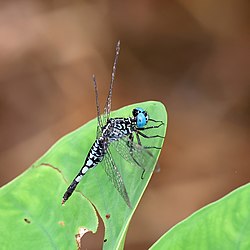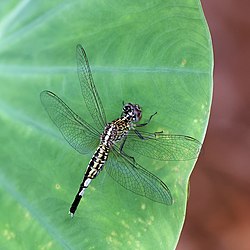Biology:Acisoma panorpoides
| Acisoma panorpoides | |
|---|---|

| |
| Male | |

| |
| Female both in Phuket, Thailand | |
| Scientific classification | |
| Domain: | Eukaryota |
| Kingdom: | Animalia |
| Phylum: | Arthropoda |
| Class: | Insecta |
| Order: | Odonata |
| Infraorder: | Anisoptera |
| Family: | Libellulidae |
| Genus: | Acisoma |
| Species: | A. panorpoides
|
| Binomial name | |
| Acisoma panorpoides Rambur, 1842
| |
Acisoma panorpoides,[2] the Asian pintail,[3] trumpet tail,[4] or grizzled pintail,[1] is a species of dragonfly in the family Libellulidae.
Distribution
It is widespread in Asia, from the Indian subcontinent to Japan , the Philippines and Indonesia.[3][1][5]
Description
It is a small dragonfly with blue eyes. Its thorax is azure-blue marbled with black to form a beautiful pattern on the dorsum and the sides. Abdomen is azure-blue, marked with black. Segments 1 to 5 have sutures finely and ventral borders more broadly black. There is a dorsal stripe which broadens at the jugal sutures and apical borders of segments. There is a speckled stripe on sub-dorsum of segments 1 to 4. There is a large ventro-lateral spot on each of segments 3 to 5. Segments 6 and 7 are black with a large spot of blue on each side. Segments 8 to 10 are entirely black. Anal appendages are bluish-white. Female is similar to the male; but with greenish-yellow eyes, thorax and abdominal segments up to 5.[6]
The characteristic shape of the abdomen will serve to distinguish this species from other Libellulidae.[6]
Habitat
It is found in subtropical or tropical swampy or marshy habitats.[3] It has a very weak and short flight and keeps close to the herbage and reeds in the heavily weeded ponds and lakes where it breeds.[6][7][8][4]
References
- ↑ 1.0 1.1 1.2 Clausnitzer, V.; Suhling, F.; Dow, R.A. (2018). "Acisoma panorpoides". IUCN Red List of Threatened Species 2018: e.T56259873A56260502. doi:10.2305/IUCN.UK.2018-1.RLTS.T56259873A56260502.en. https://www.iucnredlist.org/species/56259873/56260502. Retrieved 18 November 2021.
- ↑ "World Odonata List". University of Puget Sound. https://www.pugetsound.edu/academics/academic-resources/slater-museum/biodiversity-resources/dragonflies/world-odonata-list2/.
- ↑ 3.0 3.1 3.2 Mens, Lotte P.; Schütte, Kai; Stokvis, Frank R.; Dijkstra, Klaas-Douwe B. (2016). "Six, not two, species of Acisoma pintail dragonfly (Odonata: Libellulidae)". Zootaxa 4109 (2): 153. doi:10.11646/zootaxa.4109.2.3. ISSN 1175-5334.
- ↑ 4.0 4.1 "Acisoma panorpoides Rambur, 1842 – Trumpet-Tail". Odonata of India, v. 1.00. Indian Foundation for Butterflies. http://www.indianodonata.org/sp/569/Acisoma-panorpoides.
- ↑ K.A., Subramanian; K.G., Emiliyamma; R., Babu; C., Radhakrishnan; S.S., Talmale (2018). Atlas of Odonata (Insecta) of the Western Ghats, India. Zoological Survey of India. pp. 302–303. ISBN 9788181714954.
- ↑ 6.0 6.1 6.2 C FC Lt. Fraser (1936). The Fauna of British India, including Ceylon and Burma, Odonata Vol. III. Red Lion Court, Fleet Street, London: Taylor and Francis. pp. 330-331. https://archive.org/details/FraserOdonata3.
- ↑ C FC Lt. Fraser (1924). A Survey of the Odonate (Dragonfly) Fauna of Western India and Descriptions of Thirty New Species. pp. 434. http://faunaofindia.nic.in/PDFVolumes/records/026/05/0423-0522.pdf.
- ↑ Subramanian, K. A. (2005). Dragonflies and Damselflies of Peninsular India - A Field Guide. http://www.ias.ac.in/Publications/Overview/Dragonflies.
External links
Wikidata ☰ Q1886127 entry
 |




